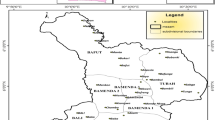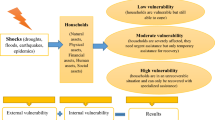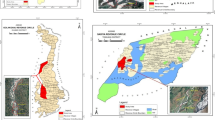Abstract
The application of a livelihood asset-based approach to adaptation policy targeting is presented through the creation of maps highlighting the spatial contrasts of access to various types of livelihood assets utilizing primary household data. Thus, the livelihood maps provide policy-makers with a tool to quickly identify areas with limited access to certain types of assets, making the latter less able to react to a changing level of climate-related risks. In the case of Bhutan, distinct spatial patterns of asset endowments is identified using five different asset indicators drawing attention to the fact that some areas facing increased level of climate-related risks lack access to productive and human capital, while other areas facing a similar situation have relatively insufficient access to financial assets. This again shows that any non-targeted policy aiming at improving households’ risk-management capacities through asset-building would have quite diverse results even among closely located districts in Bhutan. Finally, relevant policy options concerning the various dimensions of asset holdings are discussed so as to identify options that may benefit poor and vulnerable no matter if the expected outcomes of a changing climate are realized or not.






Similar content being viewed by others
Notes
The terms “no-regrets” and “pro-poor” should be seen as a way to identify policy options that would be beneficial to the poor and vulnerable, no matter what the uncertain future consequences of a changing climate.
Bhutan is 47,000 km2 large and has around 700,000 citizens. Hence, 20 districts are quite disaggregated.
Principal component analysis (PCA) has also been used to compile the necessary indicators regarding asset-based maps (Erenstein et al. 2010). While the assumptions behind factor analysis and PCA differ, the end result, that is, the inter-district ranking of asset holdings, is virtually the same. Factor analysis was finally chosen primarily due to its more relaxed assumptions regarding correlation structure.
Small area estimations of, for example, poverty are suitable for identifying local pockets of poverty, but it is more difficult to highlight the possible differences between two poor areas by focusing solely on a single welfare outcome.
Natural capital usually covers soil quality, rainfall and the like (and such factors can be difficult to allocate to specific households), while social capital is normally proxied by membership of community-level organisations or cooperatives and similar networks.
The factor loadings were taken from the first factor. For all the indicators except human capital, the eigenvalue of the first factor confirmed that the first factor loading captured the most significant part of the variation. For the human capital indicator, the second set of factor loadings was also considered due to the high eigenvalue, but it was decided to use only the first factor, as this was the only intuitively appealing one.
The categories are determined using natural jenks, meaning that within each group the average deviation from the mean is minimized, while the deviation from the other groups is maximized.
Ruminants are included to capture easily sellable assets in terms of goats and the like.
It is not surprising that ownership of physical and agricultural productive assets correlates well with the estimated community-level poverty rates, as these rely heavily on exactly the same variables.
In this case, identifying the perceived climate-related risks is mostly linked to identifying the areas in Bhutan that are most likely to be affected by changing levels of climate-related risks.
As a matter of fact, changing the timing of payments does not change primary enrolment rates, but it does a positive effect on the secondary and tertiary levels.
References
Alderman H, Haque T (2007) Insurance against covariate shocks: the role of index-based insurance in social protection in low-income countries of Africa. African Human Development Series, World Bank Working Paper no. 95, Washington, DC, World Bank
Alkire S, Foster J (2009) Counting and multidimensional poverty measurement. Oxford Poverty & Human Development Initiative (OPHI) Working Paper no. 32, Oxford Department of International Development, University of Oxford
Alkire S, Santos ME (2010) Multidimensional poverty index: research brief. Oxford poverty & human development initiative. Oxford Department of International Development, University of Oxford, Oxford
Amin S, Rai AS, Topa G (2003) Does microcredit reach the poor and vulnerable? Evidence from northern Bangladesh. J Dev Econ 70:59–82. doi:10.1016/S0304-3878(02)00087-1
Barnett B, Barrett CB, Skees J (2008) Poverty traps and index-based risk transfer products. World Dev 36:1766–1785. doi:10.1016/j.worlddev.2007.10.016
Barrera-Osorio F, Bertrand M, Lindin L, Perez-Calle F (2008) Conditional cash transfers in education: design features, peer and sibling effects. Evidence from a randomized experiment in Colombia. Policy Research Working Paper 4580, The World Bank, Washington, DC
Barrett CB (2007) Poverty traps and resource dynamics in smallholder agrarian systems. In: Delink R, Ruijs A (eds), Economics of poverty, environment and natural-resource use. Wageningen UR Frontier Series 25, Springer, The Netherlands
Barrett CB, Marenya PP, McPeak J, Minten B, Murithi F, Oluoch-Kosura W, Place F, Randrianarisoa JC, Rasambainarivo J, Wangila J (2006) Welfare dynamics in rural Kenya and Madagascar. J Dev Stud 42:248–277. doi:10.1080/00220380500405394
Baud I, Sridharan N, Pfeffer K (2008) Mapping urban poverty for local governance in an Indian mega-city: the case of Delhi. Urban Stud 45:1385–1412. doi:10.1177/0042098008090679
Bebbington A (1999) Capitals and capabilities: a framework for analyzing peasant viability, rural livelihoods and poverty. World Dev 27:2021–2044. doi:10.1016/S0305-750X(99)00104-7
Benson T (2006) Insights from poverty maps for development and food relief program targeting: an application to Malawi. Food and Consumption Division Discussion Paper 205, International Food Policy Research Institute (IFPRI), Washington, DC
Bigman D, Srinivasan PV (2002) Geographical targeting of poverty alleviation programs: methodology and applications in rural India. J Policy Model 24:237–255. doi:10.1016/S0161-8938(02)00108-4
Booysen F, Van Der Berg S, Burger R, Von Maltitz M, Du Rand G (2008) Using an asset index to assess trends in poverty in seven Sub-Saharan African countries. World Dev 36(6):1113–1130. doi:10.1016/j.worlddev.2007.10.008
Brooks N, Adger WN, Kelly PM (2005) The determinants of vulnerability and adaptive capacity at the national level and the implications for adaptation. Global Environ Chang 15:151–163. doi:10.1016/j.gloenvcha.2004.12.006
Carter MR, Barrett CB (2006) The economics of poverty traps and persistent poverty: an asset-based approach. J Dev Stud 42:178–199. doi:10.1080/00220380500405261
Carter MR, Little P, Mogues T, Negatu W (2007) Poverty traps and natural disasters in Ethiopia and Honduras. World Dev 35:835–856. doi:10.1016/j.worlddev.2006.09.010
Chantarat S, Mude AG, Barrett CB (2009) Willingness to pay for index based livestock insurance: results from a field experiment in Northern Kenya. Mimeo (available at http://www.ilri.org/ibli/images/stories/Chantarat_et_al__WTP2009.pdf)
Danish International Development Assistance (Danida) (2008) Climate change screening of Danish development cooperation with Bhutan. Ministry of Foreign Affairs of Denmark
De Janvry A, Sadoulet E (2004) Conditional cash transfer programs: are they really magic bullets? University of California at Berkeley, Mimeo
Debels P, Szlafstein C, Aldunce P, Neri C, Carvajal Y, Quintero-Angel M, Celis A, Bezanilla A, Martínez D (2009) IUPA: a tool for the evaluation of the general usefulness of practices for adaptation to climate change and variability. Nat Hazards 50:211–233. doi:10.1007/s11069-008-9333-4
Devereux S (2001) Livelihood insecurity and social protection: a re-emerging issue in rural development. Dev Policy Rev 19:507–519. doi:10.1111/1467-7679.00148
DFID (1999) Sustainable livelihoods guidance sheets. DFID, London
Dixon J, Hellin J, Erenstein O, Kosina P (2007) U-impact pathway for diagnosis and impact assessment of crop improvement. J Agric Sci 145:195–206. doi:10.1017/S0021859607007046
Eakin H, Bojórquez-Tapia LA (2008) Insights into the composition of household vulnerability from multicriteria decision analysis. Glob Environ Chang 18:112–127. doi:10.1016/j.gloenvcha.2007.09.001
Elbers C, Lanjouw JO, Lanjouw P (2003) Micro-level estimation of poverty and inequality. Econometrica 71:355–364. doi:10.1111/1468-0262.00399
Erenstein O, Hellin J, Chandna P (2010) Poverty mapping based on livelihood assets: a meso-level application in the Indo-Gangetic Plains, India. Appl Geogr 30:112–125. doi:10.1016/j.apgeog.2009.05.001
Fajth G, Vinay C (2010) Conditional cash transfers: a global perspective. mdg insights—issue 1. UNDG Policy Network for MDGs
Fields S (2005) Why Africa’s climate change burden is greater. Environ Health Perspect 113:A534–A537
Food and Agriculture Organisation of the United Nations (FAO) (2008) Climate change and food security: a framework document. FAO, Rome
Fujii T (2008) How well can we target aid with rapidly collected Data? Empirical results for poverty mapping from Cambodia. World Dev 36:1830–1842. doi:10.1016/j.worlddev.2007.10.013
Gbetitouo G (2009) Understanding farmer’s perceptions and adaptations to climate change and variability: the case of the Limpopo Basin, South Africa. IFPRI Discussion Paper 00849, IFPRI, Washington, DC
Gbetitouo G, Ringler C, Hassan R (2010) Vulnerability of the South African farming sector to climate change and variability: an indicator approach. Nat Resour Forum 34:175–187. doi:10.1111/j.1477-8947.2010.01302.x
Grosh M, Del Ninno C, Tesliuc E, Ouergi A (2008) For protection and promotion: the design and implementation of effective safety nets. The World Bank, Washington, DC
Hahn MB, Riederer AM, Foster SO (2009) The livelihood vulnerability index: a pragmatic approach to assessing risks from climate variability and change—a case study in Mozambique. Glob Environ Chang 19:74–88. doi:10.1016/j.gloenvcha.2008.11.002
Hammill A, Matthew R, McCarter E (2008) Microfinance and climate change adaptation. IDS Bull-I Dev Stud 39:113–122. Doi:10.1111/j.1759-5436.2008.tb00484.x
Hardee K, Mutunga C (2010) Strengthening the link between climate change adaptation and national development plans: lessons from the case of population in National Adaptation Programmes of Action (NAPAs). Mitig Adapt Strateg Glob Change 15:113–126. doi:10.1007/s11027-009-9208-3
Heltberg R (2007) Helping South Asia cope better with natural disasters: the role of social protection. Dev Policy Rev 25:681–698. doi:10.1111/j.1467-7679.2007.00392.x
Heltberg R, Siegel PB, Jorgensen SL (2009) Addressing human vulnerability to climate change: toward a ‘no-regrets’ approach. Glob Environ Chang 19:89–99. doi:10.1016/j.gloenvcha.2008.11.003
Holzmann R, Jorgensen S (2000) Social risk management: a new conceptual framework for social protection, and beyond. Social Protection Discussion Paper no. 0006, The World Bank, Washington, DC
IPCC (2007a) Climate change 2007: impacts, adaptation and vulnerability. In: Parry M, Canziana O, Palutikof P, van der Linden P, Hanson C (eds) Contribution of working group II to the fourth assessment report. Cambridge University Press, Cambridge, UK
IPCC (2007b) Climate change 2007: the physical science basis. In: Solomon S, Qin M, Manning M, Chen Z, Marquis M, Averyt K, Tignor M, Miller H (eds) Contribution of working group I to the fourth assessment report of the IPCC. Cambridge University Press, Cambridge, UK
Kristjanson P, Radeny M, Baltenweck I, Ogutu J, Notenbaert A (2005) Livelihood mapping and poverty correlates at a meso-level in Kenya. Food Policy 30:568–583. doi:10.1016/j.foodpol.2005.10.002
Lang C, Barrett CB, Naschold F (2010) Targeting maps: an asset-based approach to geographic targeting. Cornell University, Mimeo
Ministry of Home and Cultural Affairs (2006) National disaster risk management framework: reducing disaster risks for a safe and happy Bhutan. Disaster Management Division, Ministry of Home and Cultural Affairs. Thimphu, Bhutan
Minot N, Baulch B, Epprecht M (2006) Poverty and inequality in Vietnam: spatial patterns and geographic determinants. IFPRI Research Report No. 148, IFPRI, Washington, DC
Mool PK, Wangda D, Bajracharya SR, Kunzang K, Gurung DR, Joshi SP (2001) Inventory of glaciers, glacial lakes, and glacial lake outburst floods: monitoring and early warning systems in the Hindu Kush-Himalayan region – Bhutan. Kathmandu, ICIMOD
Morduch J (1999) The microfinance promise. J Econ Lit 37:1569–1614. doi:10.1257/jel.37.4.1569
Moser C (2006) Asset-based approaches to poverty reduction in a globalized context: an introduction to asset accumulation policy and summary of workshop findings. Brookings Institution, Washington
Moser C, Satterthwaite D (2008) Towards pro-poor adaptation to climate change in the urban centres of low- and middle-income countries. Human settlements discussion paper series. Climate change and cities discussion paper 3. IIED
Namgyel T (2003) Country presentation on Bhutan. Paper presented at UNFCCC expert workshop on local coping strategies and technologies for adaptation to climate change, October 2003, New Delhi, India
National Environment Commission (2009) Strategizing climate change for Bhutan. Royal Government of Bhutan
National Statistics Bureau (2007) Poverty analysis report 2007. Royal Government of Bhutan
Osman-Elasha B, Goutbi N, Spanger-Siegfried E, Dougherty B, Hanafi A, Zakieldeen S, Sanjak A, Atti H, Elhassan H (2006) Adaptation strategies to increase human resilience against climate variability and change: lessons from the arid regions of Sudan. AIACC working paper no. 42, AIACC project
Perge E (2010) Testing a poverty trap mechanism with Tsimane’ panel data. Chronic poverty research center working paper No. 158, Chronic Poverty Research Centre, University of Sussex
Sahn D, Stifel D (2000) Poverty comparisons over time and across countries in Africa. World Dev 28:2123–2155. doi:10.1016/S0305-750X(00)00075-9
Santos ME, Ura K (2008) Multidimensional poverty in Bhutan: estimates and policy implications. OPHI working paper no. 14, Oxford poverty and human development initiative, Oxford University
Sen A (1981) Poverty and famines: an essay on entitlement and deprivation, Oxford University Press, Oxford
Siegel PB, Alwang J, Jorgensen S (2003) Rediscovering vulnerability through a risk chain: views from different disciplines. Q J Int Agric 42:351–370
Tache B, Sjaastad E (2010) Pastoralists’ conceptions of poverty: an analysis of traditional and conventional indicator from Borana, Ethiopia. World Dev 38:1168–1178. doi:10.1016/j.worlddev.2010.01.001
Verner D (2010) Introduction. In: Verner D (ed) Reducing poverty, protecting livelihoods, and building assets in a changing climate. The World Bank, Washington, DC
Vincent K (2007) Uncertainty in adaptive capacity and the importance of scale. Glob Environ Chang 17:12–24. doi:10.1016/j.gloenvcha.2006.11.009
World Bank (2010) Bhutan economic update, April, 2010. The World Bank, Washington, DC
Yamin F, Rahman A, Huq S (2005) Vulnerability, adaptation and climate disasters: a conceptual overview. IDS Bull-I Dev Stud 36:1–14. doi:10.1111/j.1759-5436.2005.tb00231.x
Author information
Authors and Affiliations
Corresponding author
Rights and permissions
About this article
Cite this article
Jakobsen, K. Livelihood asset maps: a multidimensional approach to measuring risk-management capacity and adaptation policy targeting—a case study in Bhutan. Reg Environ Change 13, 219–233 (2013). https://doi.org/10.1007/s10113-012-0320-7
Received:
Accepted:
Published:
Issue Date:
DOI: https://doi.org/10.1007/s10113-012-0320-7




